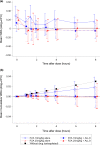Coadministration of Allopurinol To Increase Antimycobacterial Efficacy of Pyrazinamide as Evaluated in a Whole-Blood Bactericidal Activity Model
- PMID: 28739782
- PMCID: PMC5610504
- DOI: 10.1128/AAC.00482-17
Coadministration of Allopurinol To Increase Antimycobacterial Efficacy of Pyrazinamide as Evaluated in a Whole-Blood Bactericidal Activity Model
Abstract
Coadministering pyrazinamide (PZA) with the xanthine oxidase inhibitor allopurinol increases systemic levels of the active metabolite, pyrazinoic acid (POA), but the effects on bactericidal activity against tuberculosis are unknown. We randomized healthy volunteers to take a single dose of PZA (either 10 or 25 mg/kg of body weight) at the first visit and the same dose 7 days later, coadministered with allopurinol (100 mg daily; 2 days before to 1 day after the PZA dose). Blood was drawn at intervals until 48 h after each PZA dose, and drug levels were measured using liquid chromatography-tandem mass spectrometry. Whole-blood bactericidal activity (WBA) was measured by inoculating blood samples with Mycobacterium tuberculosis and estimating the change in bacterial CFU after 72 h of incubation. Allopurinol increased the POA area under the concentration-time curve from 0 to 8 h (AUC0-8) (18.32 h · μg/ml versus 24.63 h · μg/ml for PZA alone versus PZA plus allopurinol) (P < 0.001) and its peak plasma concentration (Cmax) (2.81 μg/ml versus 4.00 μg/ml) (P < 0.001). There was no effect of allopurinol on mean cumulative WBA (0.01 ± 0.02 ΔlogCFU versus 0.00 ± 0.02 ΔlogCFU for PZA alone versus PZA plus allopurinol) (P = 0.49). Higher systemic POA levels were associated with greater WBA levels (P < 0.001), but the relationship was evident only at low POA concentrations. The lack of an effect of allopurinol on WBA despite a significant increase in blood POA levels suggests that host-generated POA may be less effective than POA generated inside bacteria. Coadministration of allopurinol does not appear to be a useful strategy for increasing the efficacy of PZA in clinical practice. (This study has been registered at ClinicalTrials.gov under registration no. NCT02700347.).
Keywords: Mycobacterium tuberculosis; WBA; allopurinol; pyrazinamide; whole-blood bactericidal activity.
Copyright © 2017 American Society for Microbiology.
Figures




References
-
- Zhang Y, Mitchison D. 2003. The curious characteristics of pyrazinamide: a review. Int J Tuberc Lung Dis 7:6–21. - PubMed
-
- Yamamoto T, Moriwaki Y, Takahashi S, Hada T, Higashino K. 1987. In vitro conversion of pyrazinamide into 5-hydroxypyrazinamide and that of pyrazinoic acid into 5-hydroxypyrazinoic acid by xanthine oxidase from human liver. Biochem Pharmacol 36:3317–3318. doi:10.1016/0006-2952(87)90654-X. - DOI - PubMed
-
- Via LE, Savic R, Weiner DM, Zimmerman MD, Prideaux B, Irwin SM, Lyon E, O'Brien P, Gopal P, Eum S, Lee M, Lanoix JP, Dutta NK, Shim T, Cho JS, Kim W, Karakousis PC, Lenaerts A, Nuermberger E, Barry CE III, Dartois V. 2015. Host-mediated bioactivation of pyrazinamide: implications for efficacy, resistance, and therapeutic alternatives. ACS Infect Dis 1:203–214. doi:10.1021/id500028m. - DOI - PMC - PubMed
-
- Gumbo T, Dona CS, Meek C, Leff R. 2009. Pharmacokinetics-pharmacodynamics of pyrazinamide in a novel in vitro model of tuberculosis for sterilizing effect: a paradigm for faster assessment of new antituberculosis drugs. Antimicrob Agents Chemother 53:3197–3204. doi:10.1128/AAC.01681-08. - DOI - PMC - PubMed
Publication types
MeSH terms
Substances
Associated data
LinkOut - more resources
Full Text Sources
Other Literature Sources
Medical

